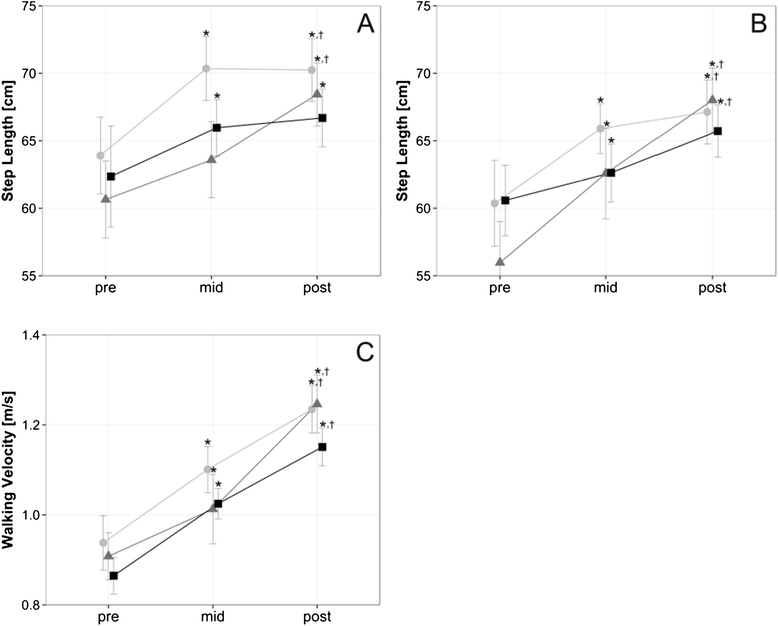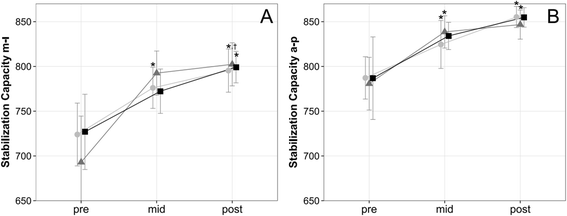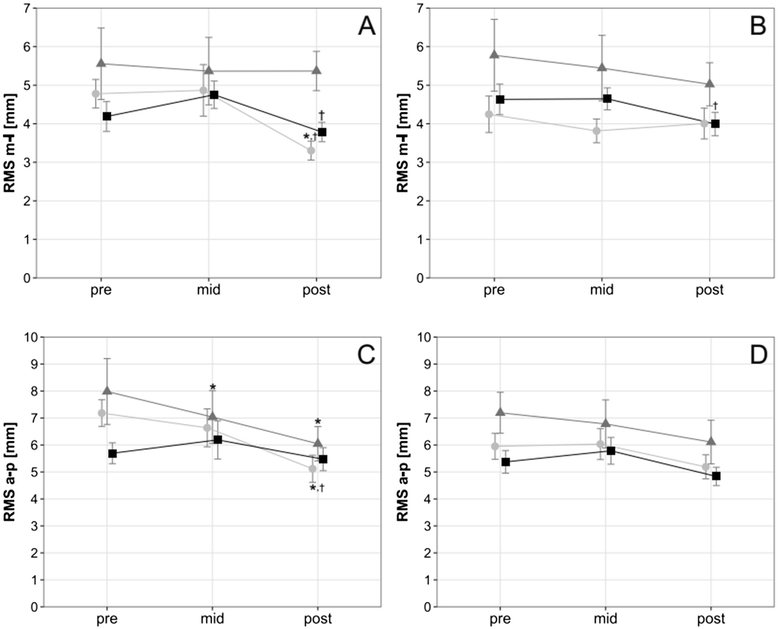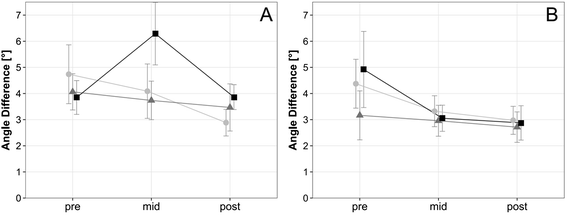Effects of sensorimotor training volume on recovery of sensorimotor function in patients following lower limb arthroplasty
- PMID: 26286593
- PMCID: PMC4545701
- DOI: 10.1186/s12891-015-0644-9
Effects of sensorimotor training volume on recovery of sensorimotor function in patients following lower limb arthroplasty
Abstract
Background: Sensorimotor function is degraded in patients after lower limb arthroplasty. Sensorimotor training is thought to improve sensorimotor skills, however, the optimal training stimulus with regard to volume, frequency, duration, and intensity is still unknown. The aim of this study, therefore, was to firstly quantify the progression of sensorimotor function after total hip (THA) or knee (TKA) arthroplasty and, as second step, to evaluate effects of different sensorimotor training volumes.
Methods: 58 in-patients during their rehabilitation after THA or TKA participated in this prospective cohort study. Sensorimotor function was assessed using a test battery including measures of stabilization capacity, static balance, proprioception, and gait, along with a self-reported pain and function. All participants were randomly assigned to one of three intervention groups performing sensorimotor training two, four, or six times per week. Outcome measures were taken at three instances, at baseline (pre), after 1.5 weeks (mid) and at the conclusion of the 3 week program (post).
Results: All measurements showed significant improvements over time, with the exception of proprioception and static balance during quiet bipedal stance which showed no significant main effects for time or intervention. There was no significant effect of sensorimotor training volume on any of the outcome measures.
Conclusion: We were able to quantify improvements in measures of dynamic, but not static, sensorimotor function during the initial three weeks of rehabilitation following TKA/THA. Although sensorimotor improvements were independent of the training volume applied in the current study, long-term effects of sensorimotor training volume need to be investigated to optimize training stimulus recommendations.
Trial registration: Clinical trial registration number: DRKS00007894.
Figures






Similar articles
-
Effect of sensorimotor training on balance measures and proprioception among middle and older age adults with diabetic peripheral neuropathy.Gait Posture. 2019 Oct;74:114-120. doi: 10.1016/j.gaitpost.2019.08.018. Epub 2019 Aug 30. Gait Posture. 2019. PMID: 31499405 Clinical Trial.
-
Functional outcomes of outpatient balance training following total knee replacement in patients with knee osteoarthritis: a randomized controlled trial.Clin Rehabil. 2015 Sep;29(9):855-67. doi: 10.1177/0269215514564086. Epub 2014 Dec 31. Clin Rehabil. 2015. PMID: 25552523 Clinical Trial.
-
Multicenter randomized controlled trial comparing early versus late aquatic therapy after total hip or knee arthroplasty.Arch Phys Med Rehabil. 2012 Feb;93(2):192-9. doi: 10.1016/j.apmr.2011.09.011. Epub 2011 Dec 21. Arch Phys Med Rehabil. 2012. PMID: 22196125 Clinical Trial.
-
Results of total joint arthroplasty and joint preserving surgery in younger patients evaluated by alternative outcome measures.Dan Med J. 2014 Apr;61(4):B4836. Dan Med J. 2014. PMID: 24814600 Review.
-
Proprioception in musculoskeletal rehabilitation. Part 2: Clinical assessment and intervention.Man Ther. 2015 Jun;20(3):378-87. doi: 10.1016/j.math.2015.01.009. Epub 2015 Jan 29. Man Ther. 2015. PMID: 25787919 Review.
Cited by
-
Exploratory insights into novel prehabilitative neuromuscular exercise-conditioning in total knee arthroplasty.BMC Musculoskelet Disord. 2022 Jun 7;23(1):547. doi: 10.1186/s12891-022-05444-0. BMC Musculoskelet Disord. 2022. PMID: 35672761 Free PMC article. Clinical Trial.
-
Baropodometry on patients after total knee arthroplasty.Musculoskelet Surg. 2018 Aug;102(2):129-137. doi: 10.1007/s12306-017-0505-9. Epub 2017 Oct 3. Musculoskelet Surg. 2018. PMID: 28971359
-
The Effect of Progressive Dynamic Balance Training on Physical Function, The Ability to Balance and Quality of Life Among Elderly Women Who Underwent a Total Knee Arthroplasty: A Double-Blind Randomized Control Trial.Int J Environ Res Public Health. 2021 Mar 3;18(5):2513. doi: 10.3390/ijerph18052513. Int J Environ Res Public Health. 2021. PMID: 33802559 Free PMC article. Clinical Trial.
-
The effects of balance training in patients with total hip arthroplasty : A randomized controlled pilot study.Orthopadie (Heidelb). 2024 Dec;53(12):955-965. doi: 10.1007/s00132-024-04570-y. Epub 2024 Oct 11. Orthopadie (Heidelb). 2024. PMID: 39392482 Clinical Trial. English.
-
Balance and proprioception impairment, assessment tools, and rehabilitation training in patients with total hip arthroplasty: a systematic review.BMC Musculoskelet Disord. 2021 Dec 20;22(1):1055. doi: 10.1186/s12891-021-04919-w. BMC Musculoskelet Disord. 2021. PMID: 34930190 Free PMC article.
References
-
- Bizzini M, Boldt J, Munzinger U, Drobny T. Rehabilitationsrichtlinien nach Knieendoprothesen. Orthopade. 2003;32:527–534. - PubMed
MeSH terms
Associated data
LinkOut - more resources
Full Text Sources
Other Literature Sources
Medical

